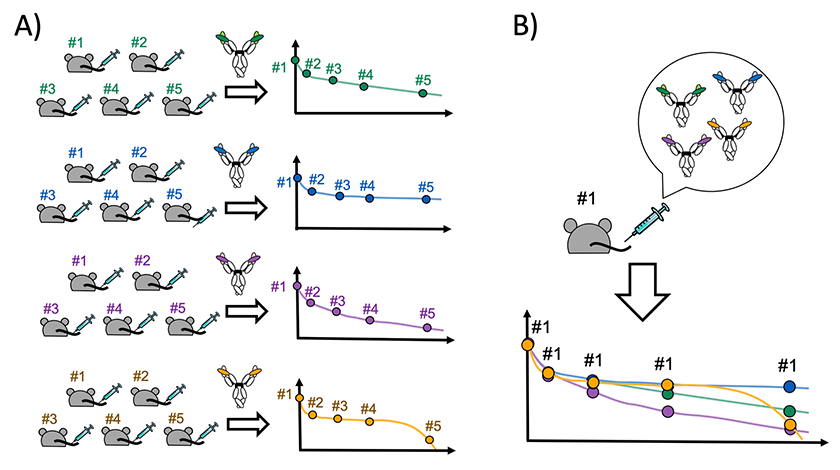Animal Research
As a corporate philosophy of dedicating ourselves to adding value by creating and delivering innovative products and services for the medical community and human health around the world, Chugai is working on development of innovative medicines.
In the development of medicines, we must conduct clinical trials to ensure that our drugs are both safe and effective. However, before medicine can be tested in humans, in compliance with worldwide regulations, we must first obtain efficacy and safety data from studies involving animals. It is not yet technologically possible to accurately recreate complicated physiological phenomenon outside of a living body, therefore testing in animals remains necessary to provide new safe and effective medicines to the world.
Chugai strives to meet the following 3Rs principles when using animals:
Replacement
Replace the use of animals with alternative non-animal methods.
In the search for medical candidate compounds, we evaluate pharmacokinetics, efficacy, and safety by incorporating non-animal methods such as human cell-based models like intestinal organoids and computer simulation *1 *2 *3.
Reduction
Reduce the number of animals involved in experiments as much as possible.
We have significantly reduced the number of animals involved in pharmacokinetic experiments by evaluating multiple candidates simultaneously in one animal *4 *5. Previously, each individual candidate had to be checked using a separate animal, which increased the overall number of animals that were needed.

Figure Schematic illustration of animal usage reduction by cassette-dosing and microsampling
(A) For single-dosing PK of each mAbs using one sample per animal, 60 mice are required to evaluate four mAbs at n=3/group and six time sampling points. (B) For cassette-dosing, the PK of a mixture of four mAbs by microsampling, four mice are required to evaluate four mAbs at n=3/group and six time sampling points.
Refinement
Avoid the suffering of animals however we can *6,*7.
To make life better for animals, we provide them with toys and nesting materials and we continuously improve the quality of their veterinary care.
Chugai complies with domestic regulations and guidelines regarding the care and use of animals, and has established the Institutional Animal Care and Use Committee (IACUC) to confirm, evaluate, and monitor compliance with the 3R principles, to review and approve experimental protocols, and to provide education and training for personnel engaged in the care and use of animals. For further details, please refer to “Policy for the Care and Use of Laboratory Animals [PDF 219KB].”
Our activities have been evaluated by AAALAC International, the independent and globally-recognized evaluation organization with which Chugai has maintained full accreditation since 2007, and will continues to be it.
Reference
- *1 Noguchi Y., Ozeki K., Akita H., Pharmacokinetic prediction of an antibody in mice based on an in vitro cell-based approach using target receptor-expressing cells. Sci Rep. 2020 Oct 1;10(1):16268. doi: 10.1038/s41598-020-73255-1.
- *2 Noguchi Y., Ozeki K., Takesue H., Akita H., A cell based assay for evaluating binding and uptake of an antibody using hepatic nonparenchymal cells. Sci Rep. 2021 Apr 16;11(1):8383. doi: 10.1038/s41598-021-87912-6.
- *3 Tanaka K., Mochizuki T., Baba S., Kawai S., Nakano K., Tachibana T., Uchimura K., Kato A., Miyayama T., Yamaguchi T., Nishihara H., Terao K., Kato Y., Robust and reproducible human intestinal organoid-derived monolayer model for analyzing drug absorption. Sci Rep. 2025 Apr 3;15(1):11403. doi: 10.1038/s41598-025-95823-z.
- *4 Nagayasu M. and Ozeki K., Combination of cassette-dosing and microsampling for reduced animal usage for antibody pharmacokinetics in cynomolgus monkeys, wild-type mice, and human FcRn transgenic mice. Pharm Res. 2021 Apr;38(4):583-592. doi: 10.1007/s11095-021-03028-6.
- *5 Nagayasu M., Takano Y., Ozeki K., Development of a New Method to Evaluate the Biodistribution of Antibodies Using Non-Radioactive Metal Labeling and Inductively Coupled Plasma Mass Spectrometry. Pharm Res. 2023 Jul;40(7):1807-1819. doi: 10.1007/s11095-023-03541-w.
- *6 Ko T., Nishiwaki K., Terada K., Tanaka Y., Mitsumata S., Katagiri R., Taketo J., Horiba N., Igata H., Mizuno K., Development of a Stereo-Vision Based High-Throughput Robotic System for Mouse Tail Vein Injection. ICRA. 2022 doi.org/10.48550/arXiv.2205.12756.
- *7 Miyagi D., Nakano H., Watanabe T., Isobe T., Evaluation of the Tunnel Handling Method: Time Required for Skill Acquisition and Cage Changing. Journal of Experimental Animal Technology. 2025 In Press.
